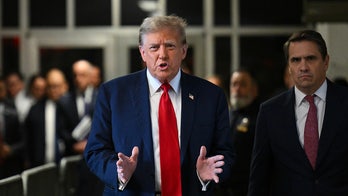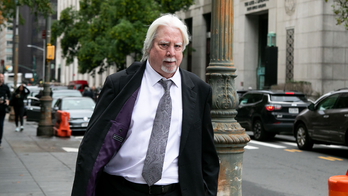The "Dawn Patrol" was out in force on Capitol Hill Friday morning.
The sun rose at 6:52 am in Washington Friday. But the Congressional press corps was way ahead of the rooster's crow as the House Intelligence Committee scheduled a 7:30 am classified hearing on the deadly attack on the U.S. Consulate in Benghazi, Libya with embattled former CIA Director David Petraeus.
Overnight cleaning crews were still hauling trash bags from House chamber when a few hundred journalists pierced the Capitol's nocturnal biorhythms. Vacuum cleaners hummed inside offices and the crackle of police radios echoed down the otherwise unpopulated marble Capitol corridors as reporters staked out doorways. TV crews posted up by the House and Senate steps and entrances to the Capitol Visitor's Center. Photographers roamed far-flung basement corridors. Reporters and producers scoured subterranean hallways which snaked toward the Library of Congress.
They were all in pursuit of their quarry, David Petraeus.
Petraeus is now a wanted man in Washington - by the press and lawmakers alike.
Once the most-respected figure in the U.S. military, few crashed as fast and as spectacularly as Petraeus. That's saying a lot in the annals of the Beltway. Back in September, many lawmakers were utterly confounded at Petraeus's presentation about the attack in Benghazi which killed U.S. Ambassador Chris Stevens and three others. Their consternation only grew after the Obama Administration and U.N. Ambassador Susan Rice characterized the incident as a "spontaneous" uprising pegged to the release of an anti-Muslim video.
Petraeus's star went supernova after he dramatically resigned following the revelation of an affair with biographer Paula Broadwell. Officials are still trying to determine if the dalliances jeopardized national security.
Pre-sunrise roll call votes aren't unheard of in Congress. Nor are post-witching hour press conferences. But no one could recall any formal Congressional hearing starting at the abrupt hour of 7:30 am. And certainly not a hearing of the magnitude of the one scheduled before the House Intelligence Committee.
There was initially some question as to whether Petraeus might appear at all. Perhaps he nixed the idea of inviting lawmakers to join him for an early-morning run along the Potomac. Few could probably match his brisk, six-minute mile pace.
Some speculated the retired general would huddle with lawmakers off-site. Others suggested he would testify via a secure video link. The press corps discussed practically every scenario except having Petraeus appear as a hologram emanating from R2 -D2.
But then word came that Petraeus would in fact testify in person before both the House and Senate Intelligence Committees. That set the stage for Friday's dramatic, pre-sunrise tableau.
If Petraeus was known for anything besides his military acumen, it was his relations with the press. A media savvy general, Petraeus assiduously courted the Fourth Estate. He sent autographed photographs of himself to those he granted interviews. He maintained email correspondence with reporters covering the Pentagon or who were embedded with troops in Iraq and Afghanistan. Some believed Petraeus hoped to use his relations with the media as a springboard to the presidency.
And then, on what was one of the most important days of Petraeus's career, he ducked the press.
Spectacularly so.
In fact, Petraeus's dodge of the scribes was unprecedented. Not just for him but for those who regularly darken the doors of Capitol Hill. House members wishing to hide from nosy reporters retreat to the cloakrooms off the floor. Senators seek sanctuary in their Capitol hideaway offices (the name says it all). Coteries of handlers escort rock stars and celebrities. Security teams whisk controversial witnesses and cabinet secretaries in and out via entrances under the House and Senate steps.
But no figure of any import made an entrance and exit from the Capitol complex as clandestine as Petraeus on Friday.
Despite the squadrons of photographers, reporters and even interns serving as sentinels, no one in the Washington press corps captured a single frame or pixel of Petraeus as he arrived for his sunrise testimony.
At 7:31 am, Intelligence Committee spokeswoman Susan Phalen stepped out of the secure facility in the basement of the Capitol Visitor's Center to announce that Petraeus was in place and the hearing was underway.
Everyone was shocked. Dozens upon dozens of journalists spread to the deepest outposts of the Capitol complex and no one saw a thing? How did he possibly get in? Rumors started to abound. Someone suggested Petraeus slept at the Capitol overnight - much like lawmakers who live in Washington on the cheap.
On Thursday night, I had a theory of how Petraeus may try to enter the Capitol. First, remember he was once the nation's top spy. The best way to conceal such operations is to simply hide in plain site. No motorcade or big production. Just come into the Capitol alongside the scores of plumbers, electricians and carpenters who report for first shift. Enter by yourself wearing a ball cap.
Or, he could be surreptitious. Come in via an entrance so obscure, virtually no one would be able to find it.
On a news day like Friday in Washington, news organizations only have so many cameras and journalists available to stake out a sprawling complex like the Capitol. You assign cameras and personnel based on high percentages of where you think the chances are greatest for someone to materialize. In addition to the usual suspects, I considered one wild card scenario. It was an entrance so far off the beaten path that it almost made sense.
And after no one visually accounted for Petraeus and word came he was in the super-secret hearing room for the classified hearing, I had a suspicion as to how this went down.
In Sir Arthur Conan Doyle's mystery "The Sign of Four," legendary detective Sherlock Holmes is deducing how a peg-legged suspect managed to ascend to an upstairs room without detection.
"We know that he did not come through the door, the window, or the chimney," Holmes says to his faithful assistant, Dr. Watson.
Watson doesn't immediately buy Holmes's theory that the peg-legged man covertly lowered himself into the room from above by a rope. But then Holmes quells Watson's skepticism with an oft-quoted literary passage.
"How often have I said to you that when you have eliminated the impossible, whatever remains, however improbable, must be the truth?" Holmes queries Watson.
Which brings us to the incipient mystery titled "The Curious Case of the Entrance of General Petraeus."
Early Friday morning, I dispatched Fox intern Juliegrace Brufke to stake out the underground service entrance to the Capitol Visitor's Center (CVC).
This inconspicuous, underground entrance is probably a good quarter-mile away from the House Intelligence Committee hearing room. It's located just below the Russell Senate Park. The entrance is off of New Jersey Avenue, NW, wedged between Constitution and Louisiana Avenues. The entrance features a long, sloped driveway which empties into a gigantic garage door. An automatic barricade blocks the drive. A special stoplight is affixed to a nearby lamppost to control traffic.
Behind the garage door is an enormous loading dock. That leads to a rabbit warren of tunnels which wind toward the CVC, the Capitol and the Senate office buildings.
Around 7 am, two marked U.S. Capitol Police cruisers pulled into the long descending driveway and drove into the CVC itself. It's rare to see any vehicles using that entrance. It's usually just restricted to service trucks.
No news organization, whether they be TV, radio, print, online, blogs, ship-to-shore nor semaphore camped out at the Capitol Friday saw Petraeus. And if you follow the Sherlock Holmes axiom about "whatever remains, however improbable," you know how Petraeus made his bootleg entrance.
By late morning, Petraeus stealthily traveled to another section of the CVC to meet with members of the Senate Intelligence Committee. When that meeting prepared to break up, reporters and photographers lined New Jersey across from the loading dock entrance. U.S. Capitol Police closed off the street to pedestrian traffic and restricted the journalists to the west side of the street.
There were a few false alarms. At one point, a maintenance worker driving a yellow, motorized dolly came up the ramp, lowering the security barrier. The man then parked the dolly and sat on the curb to puff on a cigarette.
Finally at 12:07 pm, a black Cadillac sedan with tinted windows roared up the drive. A large grey Suburban followed in close pursuit. Petraeus's silhouette was vaguely distinguishable in the backseat. The car turned onto Constitution Avenue. And that's all reporters would see of Petraeus on Friday.
Why the subterfuge?
Senate Intelligence Committee Chair Dianne Feinstein (D-CA) pinned it on the media.
"The general was eager and willing to give his views. It was very much appreciated. We didn't want to make it any more difficult. You people aren't always easy," Feinstein said. "I apologize for that."
The entire operation was glimpse into black ops. It started with a hearing held so early in the morning that Intelligence Committee member Rep. Pete King (R-NY) walked up to the House carriage entrance just after 7 am, only to discover it was locked. As a result, King briefly set off an alarm as he tried to enter the Capitol. It was an operation so covert that reporters assigned to cover the hearing could only rely on the descriptions of Petraeus provided by lawmakers.
"The general looked somber but focused on the task at hand," said Rep. Jim Langevin (D-RI) after the secretive session.
Petraeus may no longer be America's top spy. But he didn't forget the cloak-and-dagger business when he left Langley last week. He was harder to find than Twinkie in a 7-11. And to quote Sherlock Holmes, getting drawing a trace on him at the Capitol Friday was far from "elementary."




